by Ken Gargett
Everyone has a favorite Monty Python skit. Well, everyone loves the “Dead Parrot” sketch and then has another favorite Monty Python skit is what I should have said. Mine? The “Spanish Inquisition.” Michael Palin bursting into the room as Cardinal Ximenez with fellow cardinals Biggles and Fang before eventually the torture scene with . . . the comfy chair. I lose it every time I see it.
You are, not unfairly, wondering what on earth this has to do with anything, especially gin. I recently spent some (Zoom) time with the very impressive Dr. Anne Brock. One of her many achievements is to have been appointed “Grand Rectifier of the Gin Guild” in 2019, part of the Worshipful Company of Distillers. No one will ever convince me that this was not something concocted by the twisted minds of the Monty Python crew.
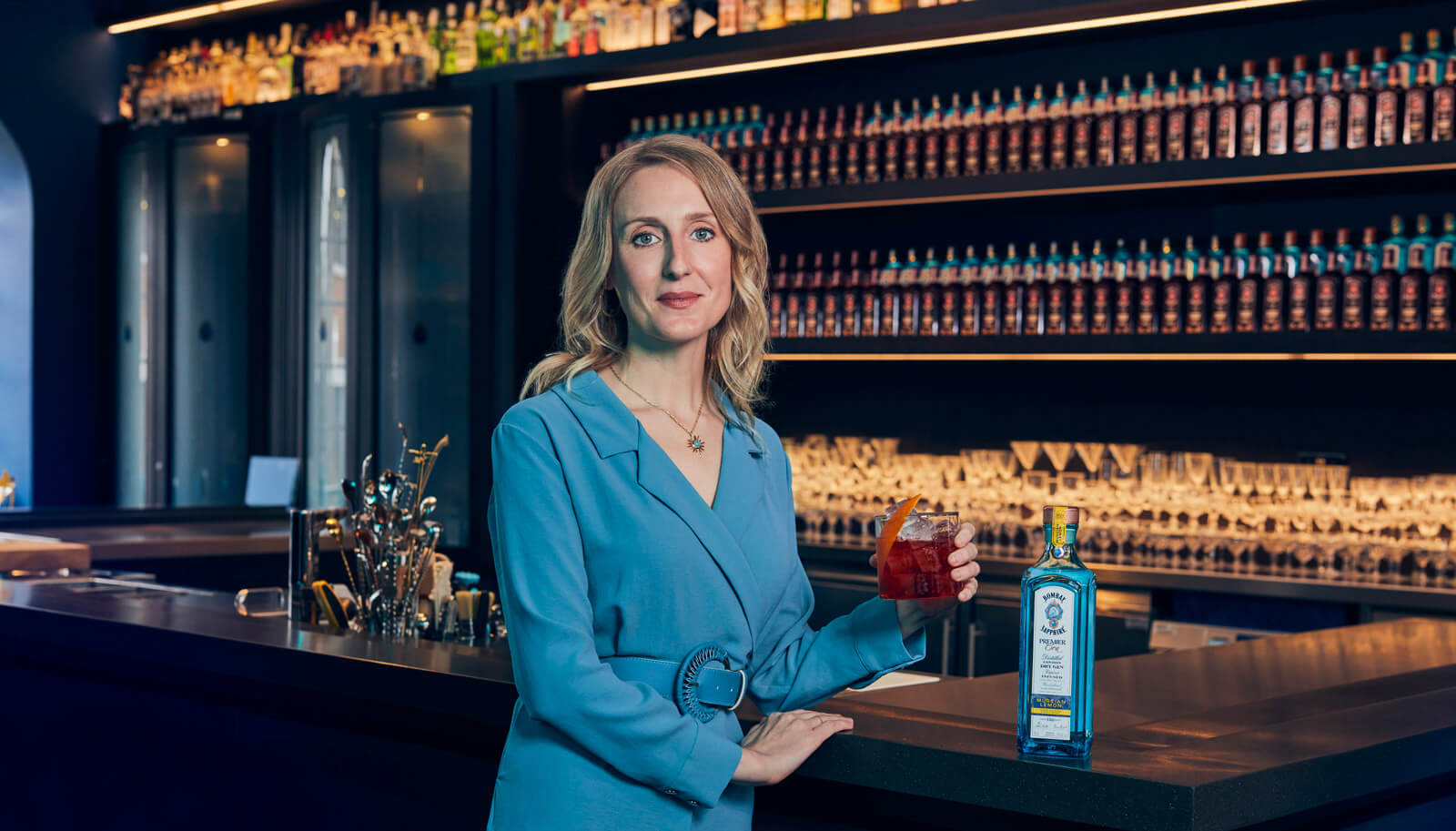
Dr. Anne Brock, master distiller for Bombay Sapphire gin and “Grand Rectifier of the Gin Guild”
That said, apparently, Grand Rectifier is a genuine, highly respected, and coveted position. Brock, who became the master distiller for Bombay Sapphire in 2017, was the first female appointed to the position.
At Bombay Sapphire, Brock works closely with the master of botanicals, Ivano Tonutti. While completing her university studies in medicine, Brock took a break to think about what career to pursue. During that time, she worked as a bartender. In the end, she returned to the hallowed halls, obtained a PhD in organic chemistry from the University of Oxford, and became a distiller.
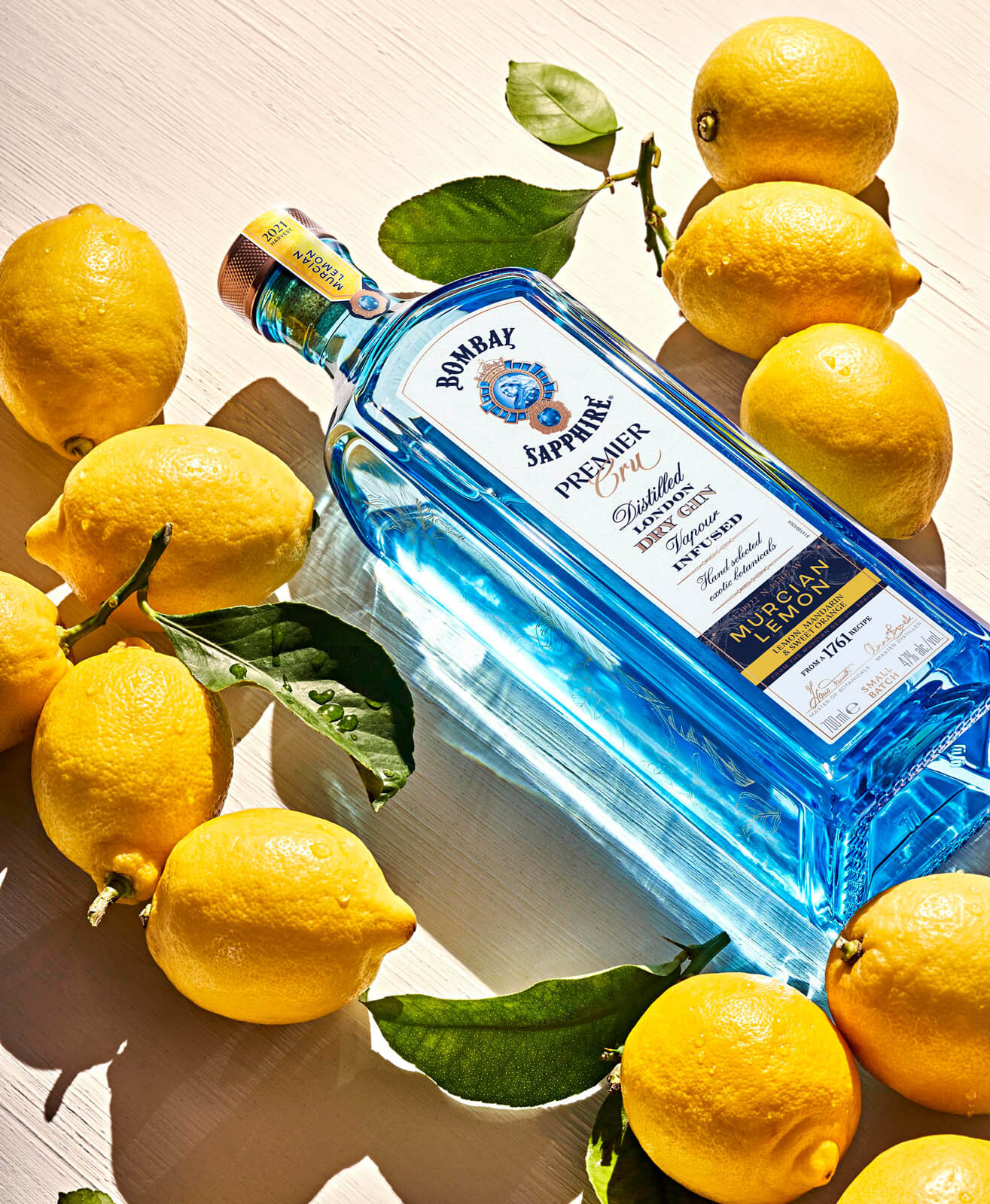
Bombay Sapphire Premier Cru Murcian Lemon gin
Bombay Sapphire is one of the gins distilled by Bombay Spirits Co, now part of the Bacardi empire. The distillery is at Laverstoke Mill in the village of Laverstoke, Hampshire, England, and has been since 2014. Prior to that, it was contracted out.
It does sound all very English countryside, and what could be more perfect for a quality gin. The mill has the distinction of being documented in William the Conqueror’s Doomsday (Domesday) Book in 1086. In the eighteenth century, it was used as a paper mill printing notes for the government, though a robbery rather spoiled that. The distillery borders the River Test, a famed English trout stream.
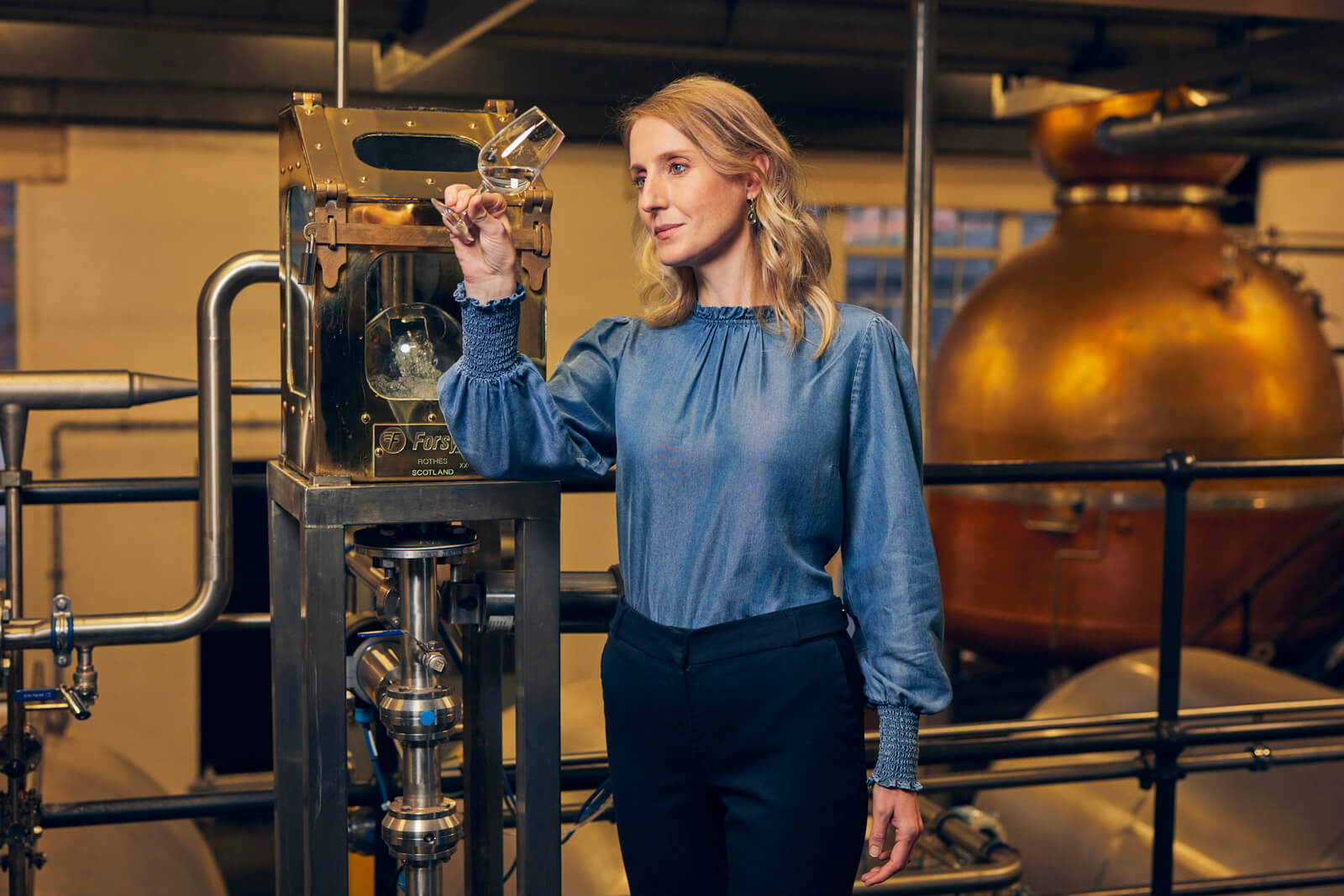
Dr. Anne Brock, master distiller for Bombay Sapphire gin
Originally launched in 1986, Bombay Sapphire became part of Bacardi a decade later in a deal that cost almost $2 billion and included Dewars as well. The vivid blue bottle is one of the most instantly recognizable in the world.
The name comes from the popularity of gin with the British Raj during their time in India and the famous sapphire called the Star of Bombay. This is a 182-carat gem found in Sri Lanka that was cabochon-cut rather than faceted, which means it was shaped and polished, the default method of working gemstones in the days before the development of gemstone cutting.
The stone was given to actress Mary Pickford (star of silent films and one of the founders of United Artists) by her husband, Douglas Fairbanks. He had purchased it from Trabert & Hoeffer jewelers in New York. It was originally set in a ring at the time. She bequeathed it to the Smithsonian, where it has been since her death in 1979.
Making Bombay Sapphire gin
The character of Bombay Sapphire comes from juniper, of course, and nine other botanicals: almond, lemon peel, licorice, orris root, angelica, coriander, cassia, cubeb, and grains of paradise.
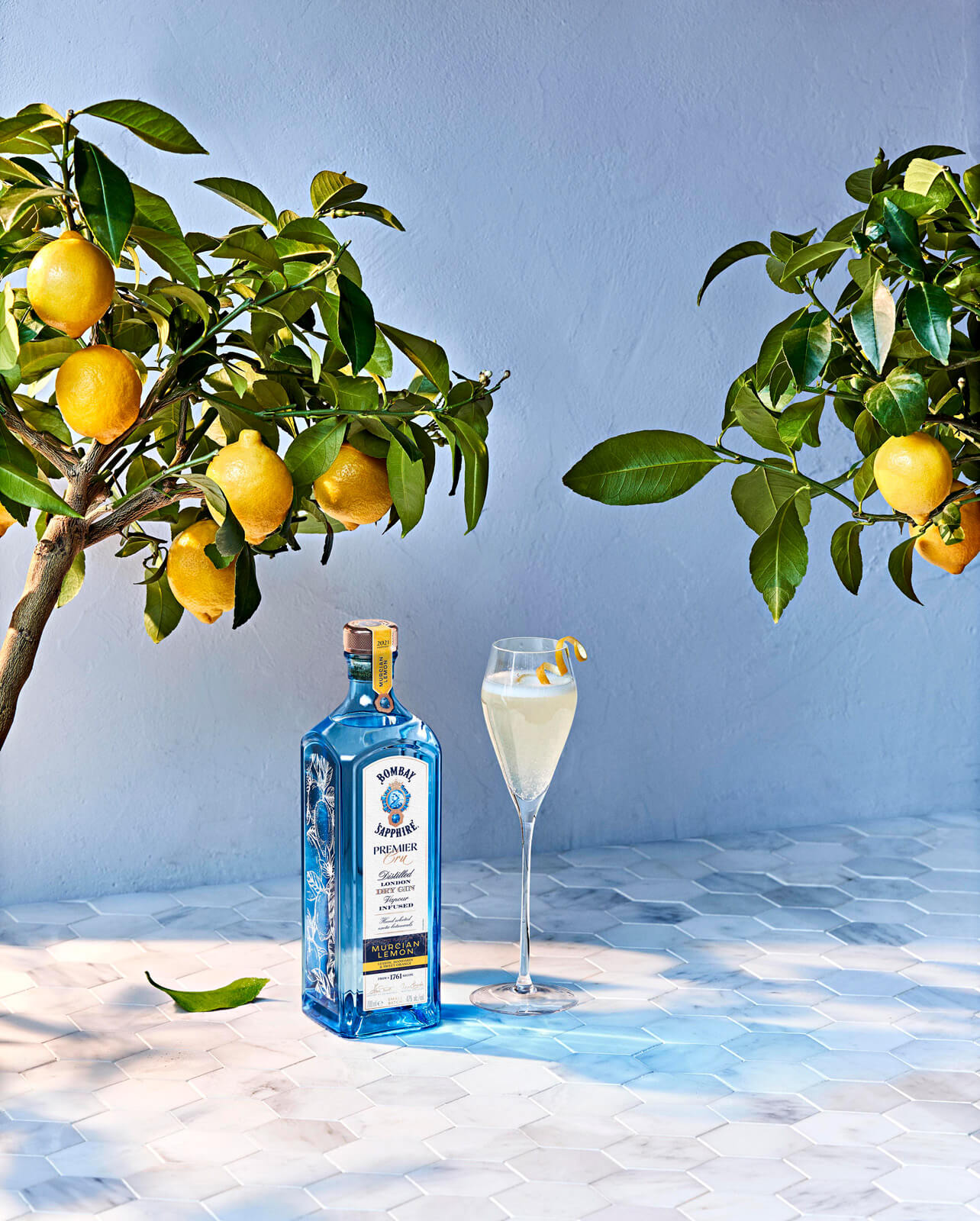
Bombay Sapphire Premier Cru Murcian Lemon Gin
Brock’s team aims for a more delicate style of gin. To ensure this, it uses vapor infusion. Alcohol is evaporated three times in a Carter Head still. The vapors are passed through a mesh with those ten botanicals to pick up the flavors (the more usual method has the botanicals incorporated using a method more reminiscent of dunking a teabag). Water from Lake Vyrnwy is used to adjust the alcohol. In most countries, that is 40 percent (a higher-percentage version is sold in various duty-free stores). The new Premier Cru is 47 percent. The reason? We’ll get to that. Bottling tales place in Glasgow.
When the new distillery was constructed at Laverstoke, Bombay also built two greenhouses to assist in growing its own botanicals. One is tropical and the other temperate. These were designed by Thomas Heatherwick, better known for the London Olympic cauldron.
As well as Bombay Sapphire, this distillery makes various other gins in its range. Bombay Original London Dry Gin contains eight botanicals rather than the ten in Sapphire. I have not seen it for a while, but I always enjoyed it and sometimes preferred it to Sapphire – as with all gins, these things depend on the use, time of day, occasion, and personal preference.
Bombay Sapphire East has two extra botanicals, Thai lemongrass and Vietnamese black peppercorns. It is bottled at 42 percent. The idea was that this gin works to counteract the sweetness found in too many tonics.
Star of Bombay Gin was made in 2015 for the UK market and included bergamot and ambrette seeds. Bombay Bramble, with a lower alcohol level of just 37.5 percent, uses blackberries and raspberries. And before you try this at home, the trick is far more than simply adding these botanicals. The recipe of proportions for all these gins is always a well guarded secret.
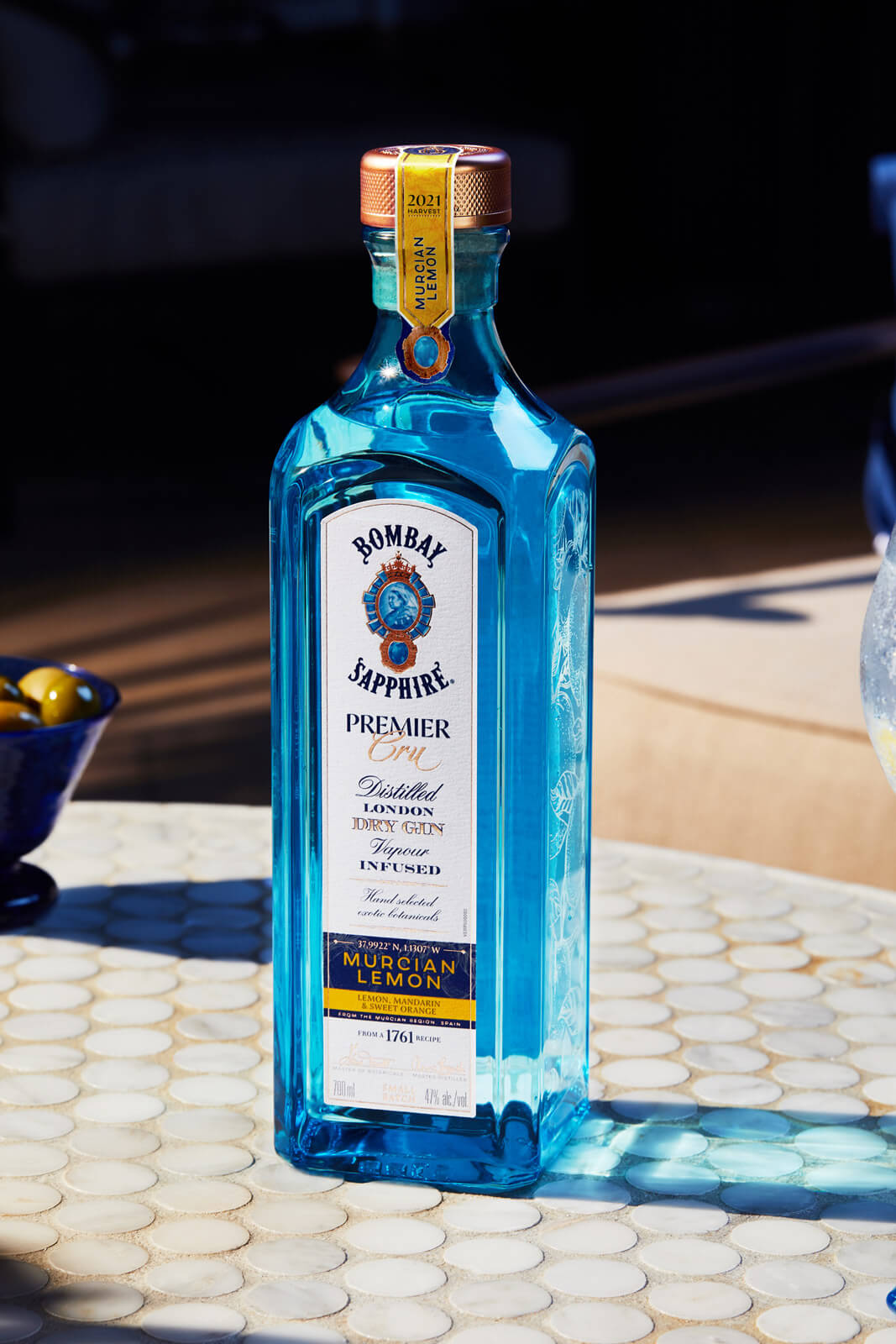
Bombay Sapphire Premier Cru Murcian Lemon gin
The precursor to Premier Cru – precursor if you like, though a fine gin on its own – was the limited edition Bombay Sapphire English Estate, which added Pennyroyal Mint, rosehip, and hazelnut. It was launched in 2019.
Sapphire, and the various offshoots, are often seen in movies and television shows or referenced in music. Fans have ranged from John Travolta to David Bowie. That it is so easily identifiable means that any time it is used it is quickly spotted by fans.
Naropa University, a “Buddhist-inspired, non-sectarian” educational facility in Boulder, Colorado, includes the Jack Kerouac “School of Disembodied Poetics” (the mind just boggles as to what that might mean or what might be taught). Its literary journal, however, co-founded by Allen Ginsberg – which hardly expands my confidence in the syllabus – is called Bombay Gin. I am a little curious here as while I am sure that the distillery is delighted, I am not sure that either Ginsberg or Kerouac were around when Bombay Sapphire was first released.
Categorizing Bombay Sapphire
Popular? It is one of the most widely used gins in the world and the fastest growing premium gin on the planet. These days, with the gincredible popularity of the spirit, that means it is one of the most loved and drunk spirits on the planet. Sapphire has always had a lovely floral and citrus touch to it with the inevitable juniper notes, of course, although they are quite restrained here. Delicacy and balance are key. This is an aromatic gin, which adds to its appeal for use in a wide variety of cocktails.
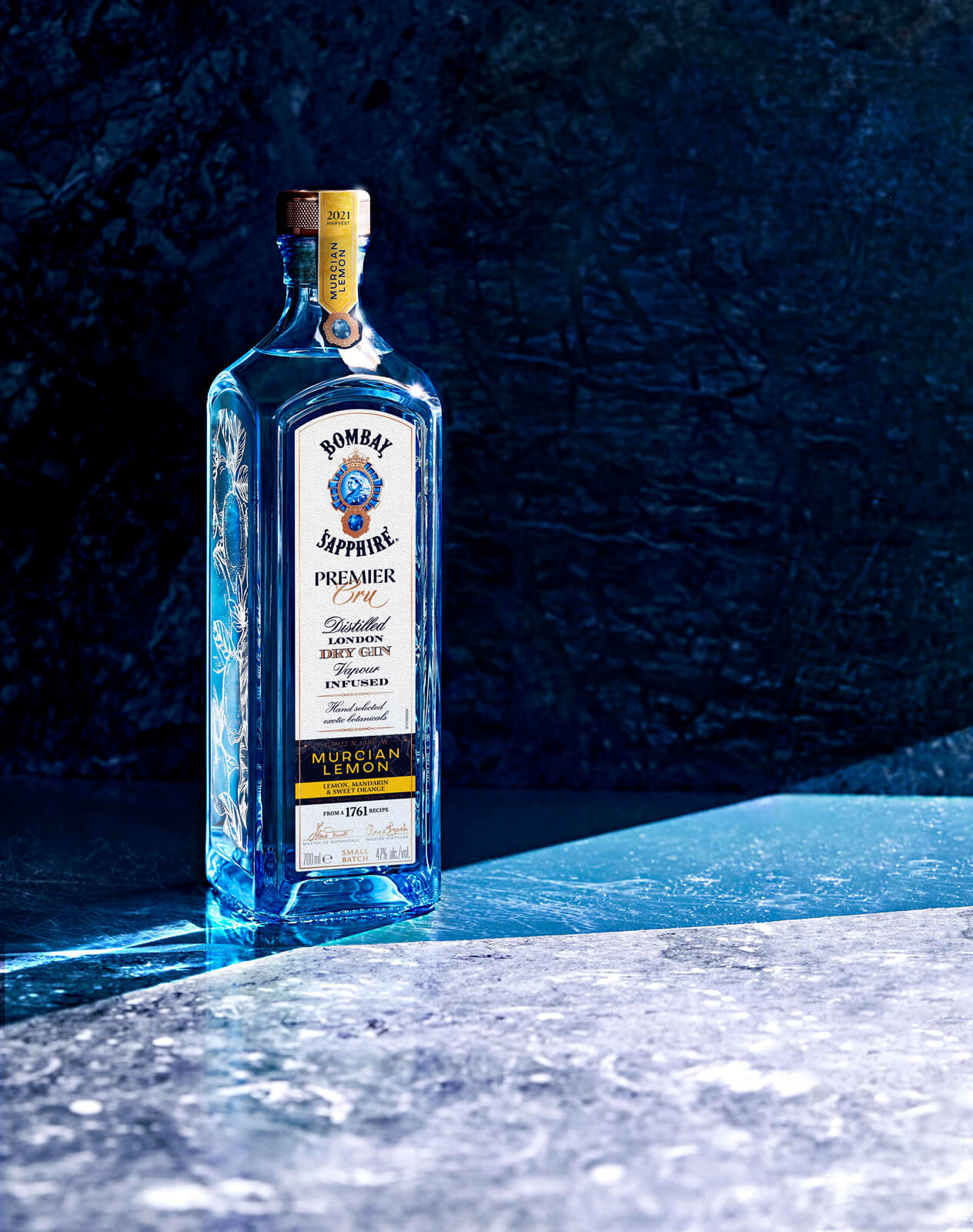
Bombay Sapphire Premier Cru Murcian Lemon Gin
Where does it fit in the overall scheme of gin? To be honest, when it comes to credit for the explosion of gins and the interest in them, I usually think of Hendrick’s as the gin that provides the bridge between the large traditional producers and the craft gin movement, but this might be doing Bombay a disservice and it surely deserves some of the accolades. In evolutionary terms, Hendrick’s and Bombay are the missing links, if you like. Gateway gins.
Bombay Sapphire is considered a London gin, but paradoxically, London gin does not have to be made in London. It just needs to be at least 37.5 percent alcohol, have no artificial ingredients, and sweetness kept to a bare minimum. Juniper flavors are essential.
Bombay Sapphire Premier Cru Murcian Lemon gin
The latest limited edition in the Bombay Sapphire universe, the Premier Cru Murcian Lemon gin, is a superb addition to the ranks.
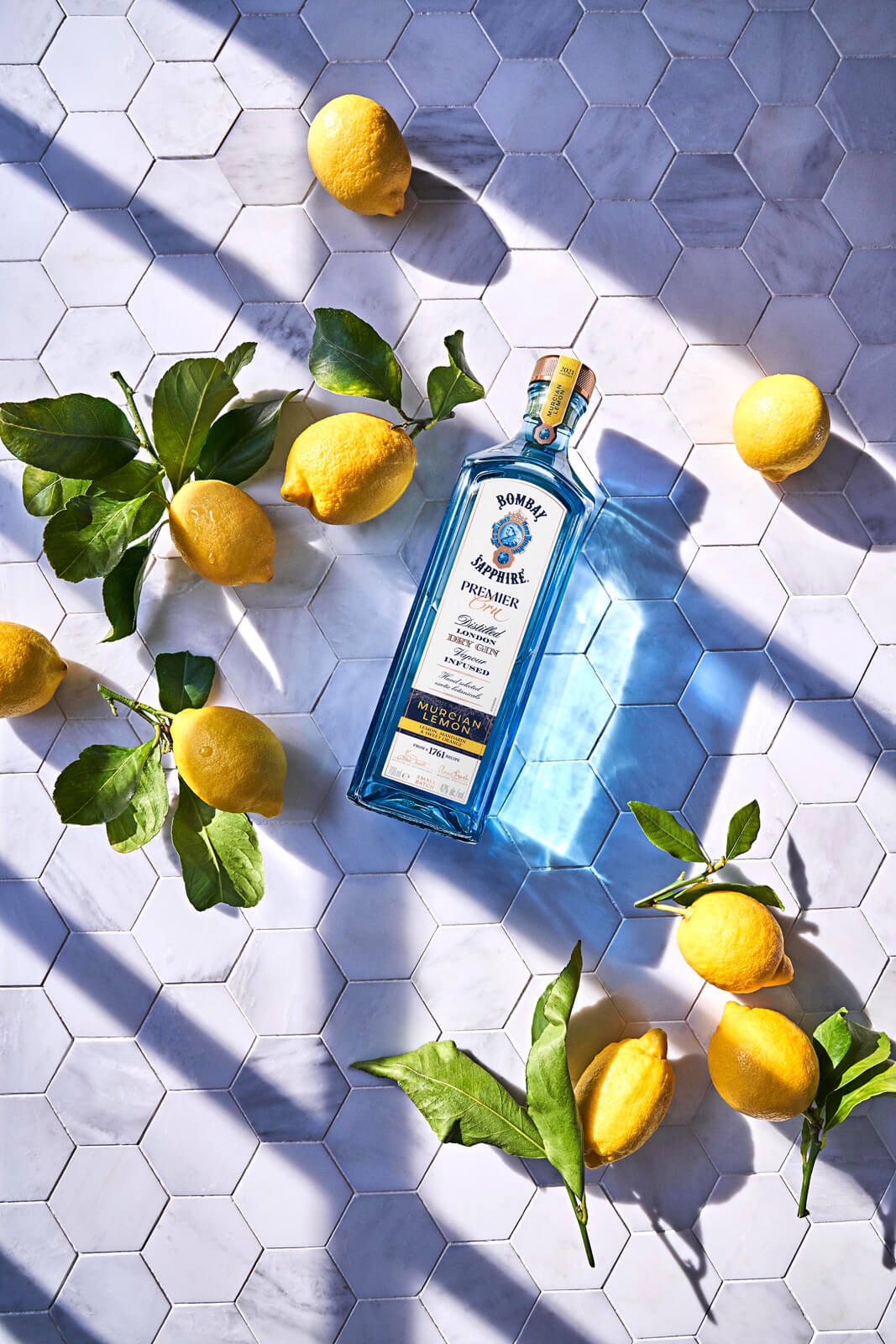
Bombay Sapphire Premier Cru Murcian Lemon gin
Can gin be elegant? I say yes. And this is beautifully elegant. Florals and spices, but mostly a glorious array of citrus notes. Finely balanced, soft, lingering and yet with some punch and vibrancy. But it always remains at the more elegant end of the spectrum. The higher alcohol percentage (47 percent) is deliberate, according to Brock. The extra oils from the infusion of citrus means that a higher level of alcohol was necessary to balance the spirit.
Based on sustainably grown Spanish Fino lemons, mandarins, and sweet navel oranges from Murcia, and yet at all times exhibiting the Bombay Sapphire “DNA,” this just screams top-class G&T. A number of top bartenders and critics opt for a martini as the ideal creation for the “standard” Bombay Sapphire so this is a perfect fit for the portfolio, and I am hoping it eventually becomes a core product in the range. Sadly, I don’t make the decision.
As for martinis, I have good intentions to do a piece on that most classic of all cocktails, so will hold off here. I will note that Brock prefers hers slightly wet – a ratio of four or five to one for vermouth to gin.
It is worth noting that during her extensive travels, Brock always takes the opportunity to listen to what the top bartenders are saying about her products. No point in trying to shove the company line down their throats. Far better to see how they use her gins and what they can achieve. It allows her to learn so much more. Having seen lord knows how many distillers and winemakers telling people that they must do this or that with the products, it is a welcome change.
The work that Tonutti does with his suppliers is remarkable. What appeals to me is that this is not some one-and-done deal with the team coming to a region, grabbing what they want/need, never to be seen again. These are long-term relationships and indicative of what the company has established around the globe.
In addition, Bombay Sapphire works with botanicals that are certified sustainable. As Brock says, these limited edition gins are “heroing the growers and harvesters.”
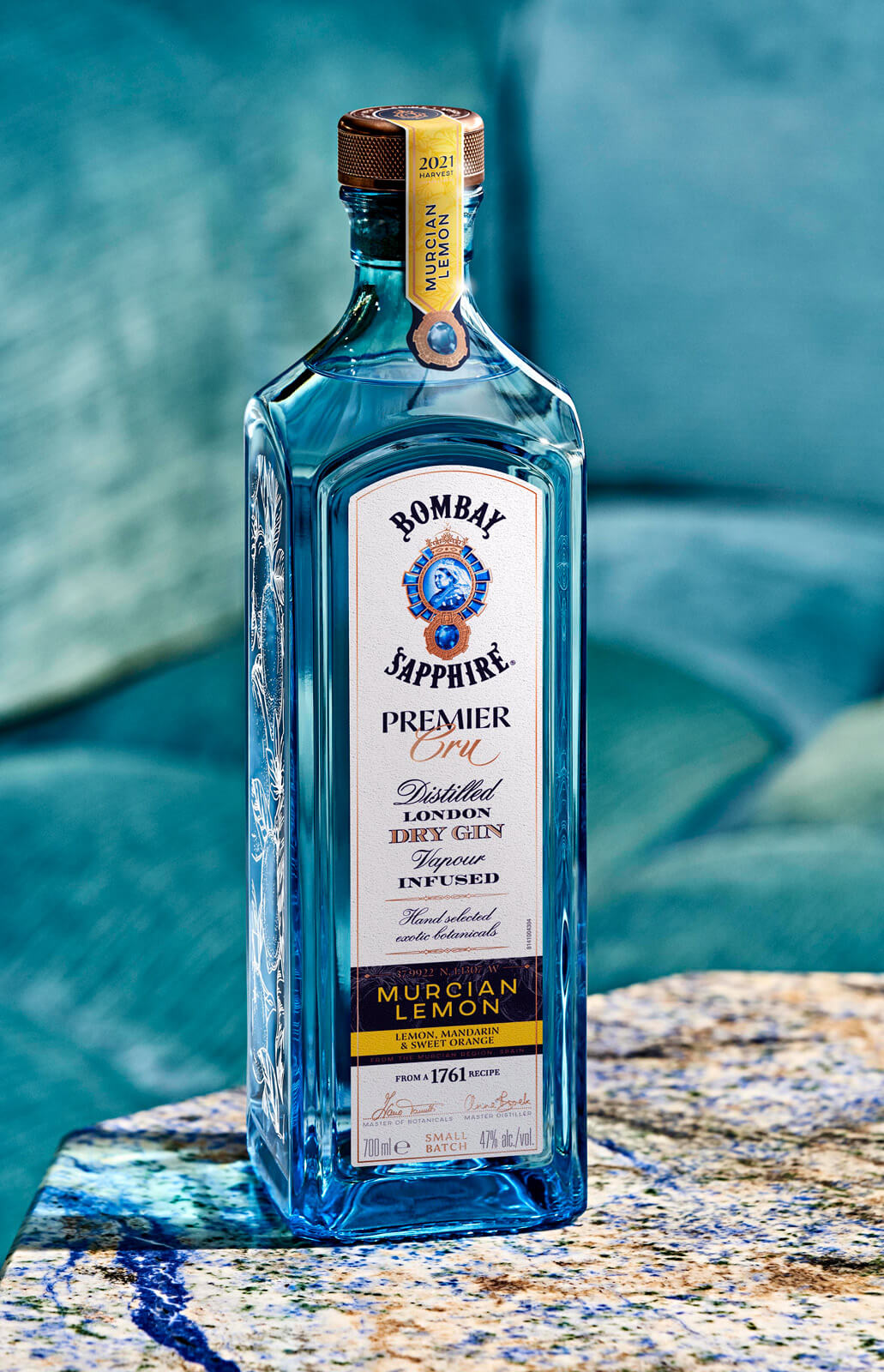
Bombay Sapphire Premier Cru Murcian Lemon gin
Personally, I have the greatest admiration for the workers who spend endless hours peeling these wonderful lemons. Years ago, I made my own Limoncello. It was great stuff, but the excruciating and boring lemon peeling that went for hours and left my fingers cut, ragged, and bloody convinced me never again.
One of the key concepts that came from the discussions I had with Brock was the importance of creativity and innovation, not just with Bombay Sapphire and gins like this one, but across the industry. I don’t think anyone could accuse the gin industry of lacking that. Quite the contrary.
As Brock says, “Innovation is the key to the phenomenal success of our industry, but it needs to move forward in the right way. Gin is such a versatile, delicious, and exciting spirit and the mix of craft distillers and global brands gives it the ability and agility to take risks, exploring new botanicals and processes which enhance the quality and variety of the juniper-led spirit.”
One final achievement of Brock is one that will surely elude the vast majority of us: she was the answer to a question posed on British television show “Mastermind.” Sadly, the contestant got it wrong. One would have imagined that an expert on the chosen subject, “gin,” would not have made such a glaring error, but then perhaps we should not be too critical of the contestant.
As they say in the classics, nobody expects the Spanish Inquisition.
For more information, please visit bombaysapphire.com/products/premier-cru.
You may also enjoy:
Hendrick’s Gin: The Original, Weird In A Good Way
Gincredible! How And Why Gin Went From Murderous Swill To 007-Level Cool
Monkey 47 Gin: From Failed Watchmaker To Making One Of The Best Gins In The World
Leave a Reply
Want to join the discussion?Feel free to contribute!





















































I certainly don’t think that BS is classified as a “premium” gin by gin fans. It’s not bottom shelf but it’s not in the same league as the very many artisanal gins now available.
I personally don’t think they need this additional product. They should simply make 47% standard for all their gin and increase the concentration of botanicals. It’s perfectly decent as it is right now. It just needs more oomph, more of a sense of occasion. It needs to be less meek. No amount of lovely photography will make up for a lacklustre drink.
I think Bombay Sapphire is a premium gin it does not have the overall ugly taste of the botanicals that many of the newer gyms have. It is perfect for martinis which I prefer to drink
no argument from me. i love so many of the new and weird gins (my current fave cocktail is a good chunk of ice, one lime fully sliced, a mix of 60/40 tonic and four pillars christmas gin) but many times when you simply want something classic.
Hi Tam. What you raise is probably worth a piece on its own.
I know plenty who agree with you. I know plenty more for whom Bombay S is their ultimate go-to. Swear by it. I tend to think a lot easier to identify an elite rum or whisky – and perhaps that is the ageing factor. Gins are more personal. At the pointy end, it is what falls into your personal spectrum and that will vary from person to person.
Fully understand that for you, gin needs that oomph, as you say. Many will agree. Others will prefer the elegance found here. And remember that gins have different uses – 80% is used in G&Ts. Many other cocktails. You’ll find occasions when BS simply does not work. Other times, it will be exactly the style required.
As an aside, the contribution that Bombay S has made to the gin explosion around the world can’t be underestimated. It is worthy of consideration for that alone.
Where we do part company on this occasion is that I like that they have spread the wings and are looking at other variations on their theme. The Premier Cru is a very good gin. And after all, there are currently around 85 million different gins on the market, give or take a few mill (or so it seems). what is one more?
Thanks for your reply Ken. How does this new Bombay compare to the std one? Is the difference similar to that between std Tanqueray and Tanqueray Ten?
Given the choice I will always go for that gorious little still on the right, despite the fact that the std Tanqueray has absolutely nothing wrong with it.
Hi Tam. i think you have nailed something on the head here. We all like that something new, something shiny. A lot of these limited spirits are that. The standards do so well because they are good. The limited ones can be as well, of course, and we all want to try them.
For me, the new Bombay is obviously a little more citric – no surprise of course. A bit more powerful. I really liked it and I think it has useful applications for certain cocktails.